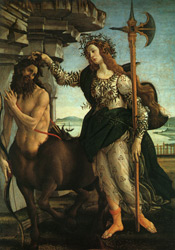| |  | Sandro Botticelli |  |
| Sandro Botticelli, original name Alessandro di Mariano Filipepi (1445-1510). Florentine early Renaissance painter whose "Birth of Venus" and "La Primavera" are often said to epitomize for modern viewers the spirit of the Renaissance. His name is derived from his elder brother Giovanni, a pawnbroker, who was called Il Botticello ('The Little Barrel'). |  |
Botticelli was apprenticed to a goldsmith. Later he was a pupil of the painter Fra Filippo Lippi. He spent all his life in Florence except for a visit to Rome in 1481-82. There he painted wall frescoes in the Sistine Chapel of the Vatican. In Florence, Botticelli was a protege of several members of the powerful Medici family. He painted portraits of the family and many religious pictures, including the famous "The Adoration of the Magi". The most original of his paintings are those illustrating Greek and Roman legends. Botticelli accepted that paganism, too, was a religion and could bear profoundly philosophical significance. His religious paintings manifest this belief by converging all truths into one. After Masaccio, Sandro Botticelli comes as the next great painter of the Florentine tradition. The new, sharply contoured, slender form and rippling sinuous line that is synonymous with Botticelli was influenced by the brilliant, precise draftsmanship of the Pollaiuolo brothers, who trained not only as painters, but as goldsmiths, engravers, sculptors, and embroidery designers. However, the rather stiff, scientifically formulaic appearance of the Pollaiuolos' paintings, which clearly follow anatomical dictates, finds no place in the painting of Botticelli. His sophisticated understanding of perspective, anatomy, and the Humanist debate of the Medici court never overshadows the sheer poetry of his vision. Although he was one of the most individual painters of the Italian Renaissance, Sandro Botticelli remained little known for centuries after his death. Then his work was rediscovered late in the 19th century by a group of artists in England known as the Pre-Raphaelites. |
|
| |
|  | | "The Birth of Venus" (1485-86) Tempera on canvas, 172.5 x 278.5 cm - 67 7/8 x 109 5/8 in. Galleria degli Uffizi, Florence, Italy. | |  | 
|  |  | "La Primavera" ("Allegory of Spring") (1477-78) , 315 x 205 cm - 10 ft 4 in x 6 ft 9 in. Galleria degli Uffizi, Florence, Italy. | | | 
|  |  | "The Adoration of the Magi" (1475-76) Oil on panel, 111 x 134 cm - 44 × 53 in. Galleria degli Uffizi, Florence, Italy. | | | 
|  |  | "The Adoration of the Magi" (1465-67) Tempera on panel, 50 x 136 cm - 19 5/8 x 53 1/2 in. National Gallery, London, UK. | |  | 
|  |  | "Madonna and Child with Six Saints (Sant'Ambrogio Altarpiece)" (1470) Tempera on panel, 170 x 194 cm - 66 7/8 x 76 3/8 in. Galleria degli Uffizi, Florence, Italy. | |  | 
|  |  | "Pallas and the Centaur" (1482) Tempera on canvas, 207 x 148 cm - 181 3/8 x 58 1/4 in. Galleria degli Uffizi, Florence, Italy. | | | 
|  |  | "Venus and Mars" (1480) Tempera on wood, 69 x 173.5 cm x 27 1/8 x 68 1/4 in. National Gallery, London, UK. | | | 
|  |  | "Mystic Nativity" (1500) Tempera and oil on canvas. National Gallery, London, UK. | |  | 
|  |  | "Portrait of a Young Man" (circa 1485) Tempera and oil on panel. National Gallery, London, UK. | | | 
|  |  | "The Punishment of Korah" (1481-1482) Fresco, 348.5 x 570 cm - 137 1/8 x 224 3/8 in. Sistine Chapel, Vatican. | | | 
|  |  | "Portrait of a Young Woman" (circa 1480) Oil on panel, 47.5 x 35 cm x 18 5/8 x 13 3/4 in. Staatliche Museen, Berlin, Germany. | |  | 
|  |  | "La bella Simonetta" (1477) Oil on panel, 61 x 41 cm - 24 x 16 1/8 in. Galleria Palatina (Palazzo Pitti), Florence, Italy. Text source: |
| Text source: 'Webmuseum' (www.ibiblio.org/wm). | |
|
|